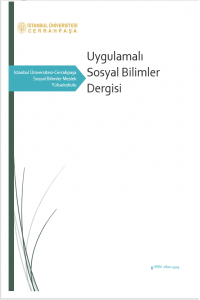Orta ve Doğu Avrupa Ülkelerinde Cari İşlemler Dengesi Sürdürülebilirliğin Ampirik Analizi
Çalışmada, Orta ve Doğu Avrupa Ülkelerinde cari işlemler dengesinin sürdürülebilirliğinin analizi için, teorik literatürde vurgulandığı üzerinde Cari İşlemler Dengesi /GSYİH (%) değişkenin durağanlığı Pesaran (2007) tarafından geliştirilen birim kök testi kullanılarak analiz edilmiştir. Çalışmadaki ekonometrik sonuçlara göre, hem ülke bazında hem panel bazında Orta ve Doğu Avrupa Ülkeleri grubu için, cari işlemler dengesinin sürdürülebilirliği sorunu tespit edilmiştir. Sonuç olarak, ülkeler cari işlemler dengesinin sürdürülebilirliğini yakında izleyerek doğru politika ve stratejileri gerektiğinde uygulamaları, cari işlemler dengesinin sürdürülebilirliğinin sağlanması açısından büyük önem arz etmektedir
Anahtar Kelimeler:
Cari İşlemler Dengesi, Sürdürülebilirlik, Orta Ve Doğu Avrupa Ülkeleri
AN EMPIRICAL ANALYSIS OF CURRENT ACCOUNT SUSTAINABILITY IN CENTRAL AND EASTERN EUROPEAN COUNTRIES
ity of the Current Account Balance / GDP (%) variable emphasized in the theoretical literature was analyzed using the unit root test developed by Pesaran (2007). According to the econometric results of the study, the problem of sustainability of the current account balance has been identified for the Central and Eastern European countries group both on country basis and panel basis. As a result, countries should closely monitor the sustainability of the current account balance and implement the right policies and strategies when necessary, which is of great importance in terms of ensuring the sustainability of the current account balance.
___
- Cuestas, J. C. (2013). The current account sustainability of European transition economies. JCMS: Journal of Common Market Studies, 51(2), 232-245.
- Cuestas, J. C., & Monfort, M. (2020). Current account sustainability in Central and Eastern Europe: structural change and crisis. Empirica, 1-13.
- Hakkio, C. S., & Rush, M. (1991). Is the budget deficit “too large?”. Economic inquiry, 29(3), 429-445.
- Holmes, M. J. (2004). Current account deficits in the transition economies. Prague Economic Papers, 13(4), 347-358.
- Husted, S. (1992). The emerging U.S. current account deficit in the 1980s: A cointegration analysis. The Review of Economics and Statistics, 74(1), 159– 166.
- Jošić, H., & Jošić, M. (2012, January). Non-interest current account sustainability in Central and Eastern European (CEEC) and Baltic countries. In Beyond the Economics Crisis: Lessons Learned and Challenges Ahead.
- Obstfeld, M. (1986). Speculative attack and the external constraint in a maximizing model of the balance of payments. Canadian Journal of Economics, 1-22.
- Obstfeld, M. (2012). Does the current account still matter?. American Economic Review, 102(3), 1-23.
- Pesaran, M. H. (2007). A simple panel unit root test in the presence of cross‐section dependence. Journal of applied econometrics, 22(2), 265-312.
- Rodionova, T. (2012). External debt dynamics as a factor of the current account sustainability in the central and eastern European countries. Actual problems of international relations, 1(106).
- Sargent, T. J., & Wallace, N. (1984). Some unpleasant monetarist arithmetic. In Monetarism in the United Kingdom (pp. 15-41). Palgrave Macmillan, London.
- Schadler, S. (2008). Are Large External Imbalances in Central Europe Sustainable?. Challenges of Globalization: Imbalances and Growth. Washington, DC: Peterson Institute for International Economics, 17-40.
- Taylor, A. M. (2002). A century of current account dynamics. Journal of International Money and Finance, 21(6), 725-748.
- Trehan, B., & Walsh, C. E. (1991). Testing intertemporal budget constraints: Theory and applications to US federal budget and current account deficits. Journal of Money, Credit and banking, 23(2), 206-223.
- Zanghieri, P. (2004). Current account dynamics in new EU Members: Sustainability and policy issues. Available at SSRN 871453.
- Başlangıç: 2007
- Yayıncı: İstanbul Üniversitesi-Cerrahpaşa
Sayıdaki Diğer Makaleler
Çevrimiçi İkinci El Alışveriş Motivasyonları: Ölçek Uyarlama Çalışması
Orta ve Doğu Avrupa Ülkelerinde Cari İşlemler Dengesi Sürdürülebilirliğin Ampirik Analizi
Elmas DEMİRCİOĞLU KARABIYIK, Hakan ÇETİNOĞLU
Koronavirüs Pandemisinin Kamu Ekonomisi Analizine Etkileri: Teorik Bir İnceleme
Türkiye'deki Ailelerin Sosyal ve Ekonomik Güvenliği: OECD ve AB Ülkeleri ile Bir Karşılaştırma
